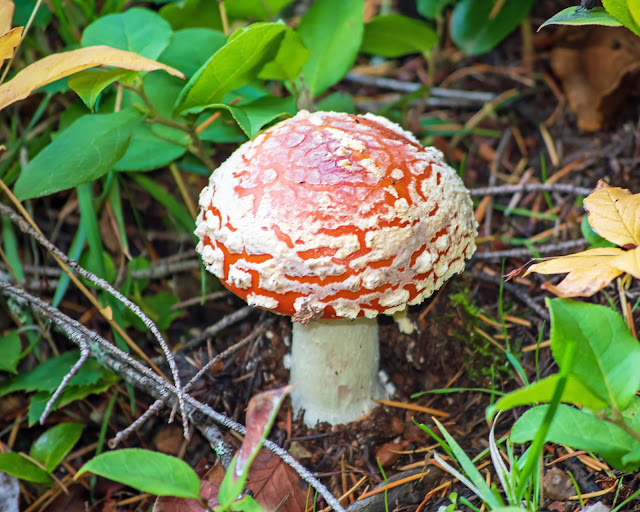There's a patch of grass and clover between the parking lot and the highway at Oyster Bay. Not a lawn, not a meadow; just an open area with a picnic bench or two under cottonwoods. I've never seen anyone crossing it, except for me and my family. Cutting across it the other day, I saw many large Amanita mushrooms, all stomped and kicked to bits. Who does this? What harm would they have done, left in place?
A couple of buttons had sprung up since the vandals left:
 |
Amanita muscaria, the fly agaric. About 2 inches across.
|
 |
Another. On the stick at the left are a bunch of tiny mushrooms, looking like shelf polypores.
|
There were a few big puffballs, too. Nobody had touched these.
 |
Mature puffball, with open pore ready to release its spores. Not edible at this stage.
|
 |
Several puffballs, Lycoperdon perlatum, here. Not ripe, edible and choice as long as it's completely white inside.
|
I poked at the brown puffball with a finger, gently; it released a puff of brown spores. But after the mistreatment of the
Amanitas, I didn't want to disturb anything, so I left it to wait for a good rain.
~~~~~~~~~~~~~~~~~~~~~
En el parque en Oyster Bay, hay un triángulo de pasto y tréboles entre el estacionamiento y la carretera. No exactamente un césped, ni tampoco tierra abandonada; hay un par de mesas para picnic y un tablero informativo, todo bajo álamos altos. Nunca he visto a nadie en este lugar, a no ser yo y mi familia, cuando les llevé a mirar el tablero.
Cruzándolo el otro día, encontré un gran número de hongos Amanita, todos pateados, machucados, hecho pedazos. ¿Quién hará tal cosa? ¡No le hacían daño a nadie!
Había dos botones, salidos después de que se fueron los vándalos. Eran de unas dos pulgadas de diámetro.
También encontré algunos hongos "puffball", que emiten nubes de esporas cuando están maduros. La primera foto muestra uno ya listo. A un toque suave de mi dedo, le salió un soplo de polvo café.
En la última foto, hay tres, dos todavía escondidos bajo tierra y hojas caídas. Así, blancos completamente por dentro, se pueden comer, y son deliciosos, fritos con mantequilla.
Los dejé en paz. Un episodio de vandalismo es más que suficiente.


















































